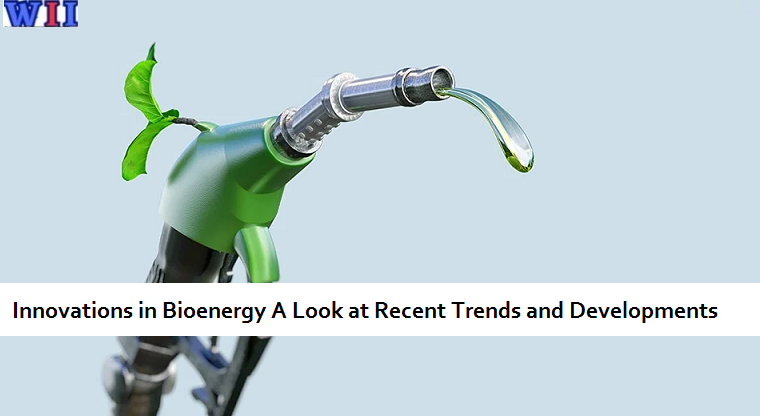Innovations in Bioenergy: Bioenergy, the harnessing of organic matter to generate heat, electricity, and fuel, has burgeoned as an indispensable linchpin in the global energy panorama. The burgeoning interest in renewable energy, amplified by environmental exigencies and the pursuit of energy independence, has intensified efforts to refine and diversify bio energy technologies.
Advancements in Biomass Conversion Technologies
Hydrolysis and Classification
Hydrolysis, the thermostatically decomposition of organic material in an oxygen-free environment, has engendered a leap in bio energy production. Its ability to convert diverse feed stocks, from wood chips to agricultural residues, into bio-oil, syn gas, and bio char provides multiple outlets for utility.
In parallel, classification, a process that transmutes organic or fossil-based carbonaceous materials into carbon monoxide, hydrogen, and carbon dioxide, is pivotal in transforming biomass into syn gas. Syn gas a versatile, energy-rich gas can be harnessed for various applications, from electricity generation to the production of chemicals and fuels.
Putrefaction
Putrefaction a process akin to roasting that alters the chemical composition of biomass, enhances the material’s fuel properties and improves its grind ability. This innovation in biomass conversion outstrips traditional methods by augmenting energy density and reducing transportation costs.
Hydrothermal Liquefaction
Hydrothermal liquefaction, a novel method for converting wet biomass into bio-crude oil, leverages high temperatures and pressure conditions. Its potential to transfigure high-moisture feed stocks, such as algae, into liquid fuel underscores its importance in the bio energy tableau.
Breakthroughs in Algae Bio fuel
Algae Cultivation
Micro algae have emerged as a bountiful and sustainable bio energy source. Different cultivation methods from open ponds to photo bioreactors offer varying yields, with advances in technology continually refining the efficiency of these processes.
Algae-to-Bio fuel Conversion
Techniques to convert algae biomass into bio fuels have proliferated, with algal bio fuels emerging as a robust contender to conventional transportation fuels. These bio fuels offer potential benefits such as a high energy yield per unit area and the ability to grow in diverse environments.
Algae Bioreactors
Innovative bioreactor designs have become instrumental in optimizing algae growth. Photo bioreactors, which provide controlled conditions for maximum growth, and open ponds, which are simpler and cheaper, both play integral roles in the cultivation landscape.
Innovations in Waste-to-Energy Conversion
Anaerobic Digestion
Anaerobic digestion the process of breaking down organic waste in an oxygen-free environment has been harnessed to convert organic waste into bio gas, a versatile energy source. Bio gas, primarily composed of methane and carbon dioxide, is an underutilized goldmine, serving as a source of heat, electricity, and transportation fuel.
Landfill Gas Recovery
Landfill gas, a natural byproduct of the decomposition of organic material in landfills, presents another renewable energy source when effectively captured and utilized. However, it also poses considerable challenges, from the technical complexities of gas capture to the mitigation of greenhouse gas emissions.
Sewage Sludge-to-Energy
Sewage sludge-to-energy technology offers a dual solution managing waste and producing energy. By converting sludge into energy through thermal processes, wastewater treatment plants could morph into energy-generating facilities, adding a new dimension to urban sustainability.
Emerging Technologies in Bio electricity
Microbial Fuel Cells (MFCs)
Microbial Fuel Cells (MFCs), which leverage microorganisms to convert chemical energy into electrical energy, represent a groundbreaking bio electricity technology. MFCs offer potential applications in wastewater treatment and remote power generation.
Bioelectricity from Agricultural Residues
Agricultural residues a globally abundant and underutilized resource offer significant potential for electricity generation. With advances in technologies like anaerobic digestion and classification, the conversion of agricultural waste into energy has become increasingly efficient and cost-effective.
Solid Oxide Fuel Cells (SOFCs)
SOFCs, which generate electricity through a high-temperature petrochemical reaction, hold great potential for bio energy applications. However, they present an array of challenges, from the high operating temperatures to material degradation, which need to be surmounted to facilitate widespread adoption.
Integration of Bio energy with Other Renewable Sources
Bio energy and Solar Power
Examining the symbiotic relationship between bio energy and solar energy reveals the potential of hybrid systems. Such systems could offer increased energy efficiency and reliability, harnessing solar power during the day and bio energy when sunlight is unavailable.
Bioenergy and Wind Power
The integration of bioenergy with wind turbines introduces a diversified renewable energy mix, promoting resiliency and reliability. Co-location strategies, which capitalize on the geographical correlation between wind and biomass resources, can enhance the benefits of such integrated projects.
Bioenergy and Energy Storage
Bioenergy can play a crucial role in energy storage technologies, providing a dispatchable renewable energy source for grid stability. By offering a steady power supply, bioenergy can counteract the intermittency of other renewable sources like wind and solar power.
Policy and Market Trends in Bioenergy
Government Incentives and Regulations
Policies and incentives play a cardinal role in promoting bioenergy development. Certain countries serve as paragons, with successful policies that stimulate investment, innovation, and sustainable practices in the bioenergy sector.
Investment Opportunities in Bioenergy
The bioenergy sector presents a plethora of investment opportunities. However, assessing the economic viability of bioenergy projects necessitates an understanding of market dynamics, technological advancements, and policy support.
Environmental Impacts and Sustainability
Bioenergy production presents a delicate balancing act between environmental benefits and challenges. While it offers a renewable alternative to fossil fuels, it can also engender significant environmental impacts, necessitating a commitment to sustainable practices.
Conclusion of Innovations in Bioenergy A Look at Recent Trends and Developments
The bioenergy landscape is teeming with innovation and burgeoning opportunities, from advancements in biomass conversion technologies to breakthroughs in algae biofuels and waste-to-energy conversion. As we navigate toward a renewable energy-driven world, bioenergy could serve as a key piece in the puzzle, helping to diversify our energy mix, mitigate environmental impacts, and stimulate sustainable economic growth.
FAQs
Q1: What is bio energy?
Ans: Bioenergy is the production of energy using organic materials, typically plant matter or waste.
Q2: How does hydrolysis contribute to bio-energy production?
Ans: Hydrolysis is a process that thermally decomposes organic materials in an oxygen-free environment, producing bio-oil, syngas, and bio char for energy generation.
Q3: Why is algae considered a potential source for bio fuel?
Ans: Algae is a promising bio fuel source due to its high energy yield per unit area, ability to grow in diverse environments, and potential for carbon dioxide capture.
Q4: What role does anaerobic digestion play in waste-to-energy conversion?
Ans: Anaerobic digestion breaks down organic waste in an oxygen-free environment, producing biogas that can be used for heat, electricity, and transportation fuel.
Q5: How does the integration of bioenergy with other renewable sources enhance energy efficiency and reliability?
Ans: Integration allows for a balanced and diversified energy mix, using bio energy to supplement other renewable sources during periods of low output, enhancing grid stability and resilience.
Our Reader’s Queries
What are the technologies for bioenergy?
Cutting-edge bioenergy technologies encompass a range of innovative solutions, such as liquid biofuels derived from bagasse and other plants, biogas generated through anaerobic digestion of residues, bio-refineries, wood pellet heating systems, and more. These advanced technologies offer a sustainable and eco-friendly alternative to traditional energy sources, paving the way for a cleaner and greener future.
How can bioenergy be improved?
To boost the effectiveness of biomass energy, a viable solution is to utilize waste biomass from various sources such as food, organic waste, animal waste, agricultural waste, and production waste as an alternative feedstock for energy production. This approach can significantly enhance the efficiency of biomass energy and reduce the amount of waste that would otherwise end up in landfills. By repurposing these materials, we can create a more sustainable and eco-friendly energy source that benefits both the environment and our economy.
What is the future of bioenergy?
Bioenergy is a reliable and eco-friendly source of electricity that perfectly complements the power generated by variable renewables. By 2030, it is expected to generate around 1,300 TWh of electricity, which is almost double the amount generated in 2022. This will account for approximately 3.5% of the total demand for electricity.
What are the emerging biomass technologies?
New and exciting ways to make use of biomass are on the rise. These include integrating biorefinery processes, adopting circular bioeconomy practices, and creating biobased materials. With these innovative technologies, we can make the most of our natural resources and reduce waste.



